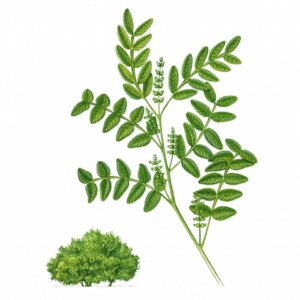
Find out more about the Pistacia lentiscus plant of our Aromatherapy Herbarium blog series.

PISTACIA LENTISCUS
Pistacia lentiscus
DESCRIPTION

A regular of the maquis scrubland and garrigues, Pistacia lentiscus, also called “mastic” or “terebinth”, is a shrub of the Anacardiaceae family, which may reach three metres.
ADVICE
Makes sure you have an essential oil obtained by distillation. The absolutes obtained using solvents do not have the same therapeutic properties. Essential oil of Pistacia lentiscus must be diluted for cutaneous use. Children must not be present during its diffusion.
DO NOT USE IN
– pregnant or breast feeding women,
– children under the age of six years,
– persons allergic to one of the components (geraniol, linalool, limonene),
– subjects with asthma without the advice of an allergologist before the first use,
– regular internal use in persons with kidney failure.
RECIPES
Digestive pains
3 drops of EO of Pistacia lentiscus, 30 drops of calophyllum CO.
Apply the mixture by massaging the abdomen. Repeat morning and evening.
Haemorrhoids
Apply 2 drops essential oil of Pistacia lentiscus diluted in 2 drops of carrier oil on the haemorrhoidal vein after each shower and each bowel movement.
Heavy legs, varicose veins
5 drops of EO of Pistacia lentiscus, 50 drops of calophyllum CO.
Apply the mixture on the zone concerned. Repeat the application morning and evening.

It grows in Mediterranean climates and its name derives from the Latin lentus (viscous) referring to its gum. Its leaves are green and persistent, and resemble those of the olive tree. It has a small, non-comestible fruit with a stone.
Pistacia lentiscus was used to cure all ailments or almost in the ancient pharmacopoeia. The Encyclopaedia states that its decoction “was celebrated as potable vegetable gold”. It is an interesting panacea to cure gout, stomach weaknesses, relieve stubborn vomiting, dissipate winds, expel urine and firm loose teeth”. The essential oil of Pistacia lentiscus is certainly multivalent, however its ambitions are much more limited. The Greeks still use it to perfume their ouzo. In the old days in Corsica, a “listincu” collar was put on dogs to preserve them from sickness and a branch was placed in barrels to disinfect them. This is the reason why bars in Ajaccio were identified to passers-by with a Pistacia lentiscus branch.
CULTIVATION AND PRODUCTION / PISTACIA LENTISCUS
is present in Morocco (since the 1950s), in Algeria and in Corsica. The yields are only profitable when the tree reaches adulthood between ten and fifteen years.
FRAGRANCE
The odour of essential oil of Pistacia lentiscus is intense and herbaceous.
EXTRACTION AND YIELD
Steam distillation of the branches and flowers gives essential oil of pistacia lentiscus. Its yield is excessively low: 0.015%, i.e. only fifteen grams of essential oil per hundred kilograms of plant, therefore its price is high.
CHEMICAL FORMULA
The chemical constituents of essential oil of Pistacia lentiscus are principally monoterpenes (75%), sesquiterpenes (15%), some monoterpenols and sesquiterpenols.
MAIN INDICATIONS
A decongestant of the venous and lymphatic systems, essential oil of Pistacia lentiscus treats varicose veins and venous stasis, phlebitis and haemorrhoids.


Leave a Comment